| dc.description.abstract | This dissertation includes three sections, all study the issues related to the financial crisis. The Section Two challenges the conventional wisdom that government spending is effective and labor tax cuts are not effective, when interest rate is at lower bound (LB). I use a dynamic stochastic general equilibrium (DSGE) New Keynesian model with labor search and matching frictions to evaluate the effectiveness of fiscal policy. Labor search and matching frictions generate a steep aggregate supply curve, which changes the comparative curvature to the aggregate demand curve at the lower bound. Labor tax cuts are expansionary rather than contractionary, while government spending is not effective. The policy implication is that firms’ supply side factors should be considered when conducting fiscal policy. After the Financial Crisis in 2008, the Gross Domestic Product (GDP) of the United States recovered only slowly to its pre-crisis level. There are two notable phenomena after the Great Recession: the fall in the labor force participation rate and the decline of the growth rate of Total Factor Productivity (TFP). In Section Three, I build a Dynamic Stochastic General Equilibrium (DSGE) model that includes endogenous growth and dynamic labor market components (including labor force participation), the first of its kind in the literature. A Bayesian estimation is applied to this model. I find four shocks (a monetary policy shock, a government spending shock, a financial related shock, and a labor productivity shock) can explain most of the variation in GDP that occurred after the financial crisis. Section Four evaluates and backtest commonly used Value-at-Risk(VaR) methods in practice, for three portfolios of assets: equities, bonds and currencies. Specifically, I compute one-dayahead forecasts for the time period from 2001 to 2018, and compare them to the realized daily profits and losses of these portfolios. Portfolio-based methods like Variance-Covariance produce very conservative estimates in general. The performances of VaR methods are related to the VaR confidence interval, underlying portfolio and the sample periods. The underlying properties of the distribution of a portfolio should be taken into consideration when choosing the VaR method. | en |


